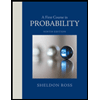Just like we went from a single to a double integral, we can add another dimension to create a triple integral. One (hard-to-visualize) interpretation of a triple integral is the hyper-volume of a 4-dimensional region. We can interpret triple integrals in other ways depending on the context of the problem. 1. Compute the probability P(Y > X). And draw a graph showing how we get the bounds. Note: the answer fpr P(Y>X) is 7/27
Just like we went from a single to a double integral, we can add another dimension to create a triple integral. One (hard-to-visualize) interpretation of a triple integral is the hyper-volume of a 4-dimensional region. We can interpret triple integrals in other ways depending on the context of the problem. 1. Compute the probability P(Y > X). And draw a graph showing how we get the bounds. Note: the answer fpr P(Y>X) is 7/27
A First Course in Probability (10th Edition)
10th Edition
ISBN:9780134753119
Author:Sheldon Ross
Publisher:Sheldon Ross
Chapter1: Combinatorial Analysis
Section: Chapter Questions
Problem 1.1P: a. How many different 7-place license plates are possible if the first 2 places are for letters and...
Related questions
Question
Just like we went from a single to a double
create a triple integral. One (hard-to-visualize) interpretation of a triple integral is the
hyper-volume of a 4-dimensional region. We can interpret triple integrals in other ways
depending on the context of the problem.
1. Compute the

Transcribed Image Text:What is P(y> x) ?
315
S12
413 2-2/2/2 4-x-24
!!
xyz² dz dy dx
Expert Solution
This question has been solved!
Explore an expertly crafted, step-by-step solution for a thorough understanding of key concepts.
Step by step
Solved in 4 steps with 11 images

Recommended textbooks for you

A First Course in Probability (10th Edition)
Probability
ISBN:
9780134753119
Author:
Sheldon Ross
Publisher:
PEARSON


A First Course in Probability (10th Edition)
Probability
ISBN:
9780134753119
Author:
Sheldon Ross
Publisher:
PEARSON
